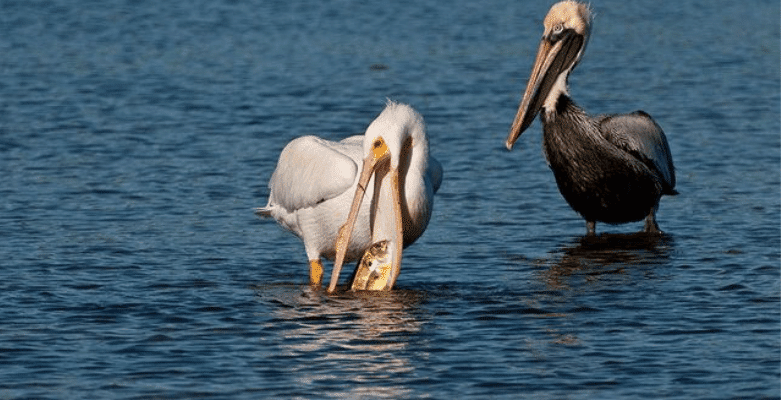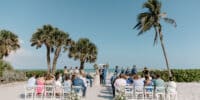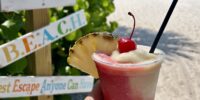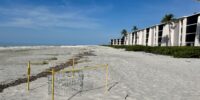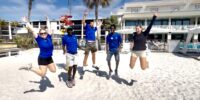Protecting the Birds of Sanibel
Did you know that you can be a lifesaver every time you visit the beach? Sanibel Island is an essential nesting site for many shorebirds, particularly Snowy Plovers. The shorebird population is currently in decline, but you can be a part of making sure these birds have a comfortable and safe habitat when they arrive in Florida after a long flight during migration. With SCCF’s new Be a Life Saver Campaign, we’re working to educate residents and visitors on the best practices to protect our bird population.
Here are a few simple ways you can be a part of saving these shorebirds lives:
Keep pets leashed
Pets off of their leashes have the ability to disturb and possibly even destroy nesting sites which may lead to killing baby chicks. A simple way to prevent this is keeping a careful eye on your pets and making sure they are always on a leash.
Never chase birds
Chasing birds may seem fun, but it really frightens them and isn’t good for their health. Another way you can be a lifesaver is to walk around the birds and let them continue on their path.
Properly dispose of trash
Properly disposing of trash isn’t just helpful for the environment, it could prevent a bird from getting tangled in it or ingesting it. Leaving your trash on the beach also attracts predators, which increases the chances of shorebird death. Take those few extra steps and put your waste in the trash can, it will be worth it.
Next time you take a trip to Sanibel, stop by J.N. “Ding” Darling – National Wildlife Refuge to go bird watching! Below are some shorebirds you are likely to spot and some that are very rare to see.
Common Bird Species
The Great Egret
Photo by Rebecca Clemens, @dingdarlingwildlifesociety
Great Egrets have very distinct characteristics making them hard to miss! One unique characteristic is their height. They are over three feet tall and have a long, sharp yellow bill and long black legs. The Great Egret has completely white feathers and when they fly, they tuck in their s-curved neck and extend their long legs beyond their tail. They are one of Sanibel’s year-round residents and wade around in the waters like they own the place!
Brown Pelican
Photo by Jim Bennight, @dingdarlingwildlifesociety
The Brown Pelican is the big bird on campus. They are one of the best-known birds of the coast and you can spot them year-round in Fort Myers and Sanibel. The Brown Pelican is brown, as its name suggests, and it has a huge bill that serves as a pouch for scooping up fish as it dives into the water. If you see a pelican with a brown head, you’ve spotted a young one! A good way to distinguish the young from the adults is the color head. Adults will have white heads. The Brown Pelican was an endangered species in the 1970’s, but because people were able to help with conservation, now there’s an abundance of the species.
Special Bird Species Seen Seasonally
Great White Pelican
Photo by Steve Hilger, @dingdarlingwildlifesociety
Sanibel Island is nearly 4,000 miles away from the Great White Pelican’s typical habitat, so it is very rare to spot one on the island. They are one of the largest birds in North American with a 9-foot wingspan, giving them their name, the GREAT White Pelican. This species is all white with black feathers on its wings that are only visible when they fly. The most common places to find the Great White Pelican are around lakes, marshes, and salt bays.
Black-Necked Stilt
Photo by Peg D’Entremont, @dingdarlingwildlifesociety
You will most likely find the Black-Necked Stilt in the Spring and Summer at Sanibel. This species appears white from below and black from above and has a unique set of pink legs that add a touch of color! They have a needle-like bill to help them as they feed on small creatures at the surface of the water. Black-Necked Stilts like to wade in shallow fresh-water areas.
Snowy Plover
Photo by Paul McKenney, @dingdarlingwildlifesociety
We are currently right in the middle of Snowy Plover nesting season (February – August). Snowy Plovers are an endangered bird species and approximately 10 pairs currently call Sanibel home. However, they are a rare sight. SCCF staff mark their nests, typically beginning in April, to identify, track and keep the species safe. Due to their size and incredible camouflage, these nests can be hard to spot. Keep an eye out when you’re exploring the beach and remember to keep a respectful distance if you come across any wildlife.
Help conserve our precious wildlife and be a lifesaver! Keep an eye out for our flying friends and let us know if you see any rare species!
Header photo by Kent Jager, @dingdarlingwildlifesociety

